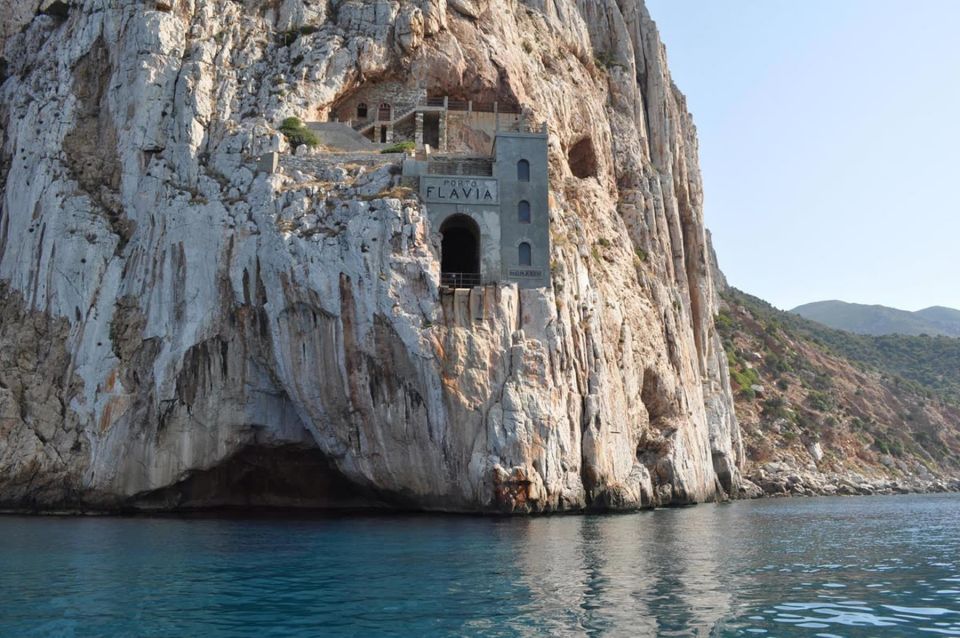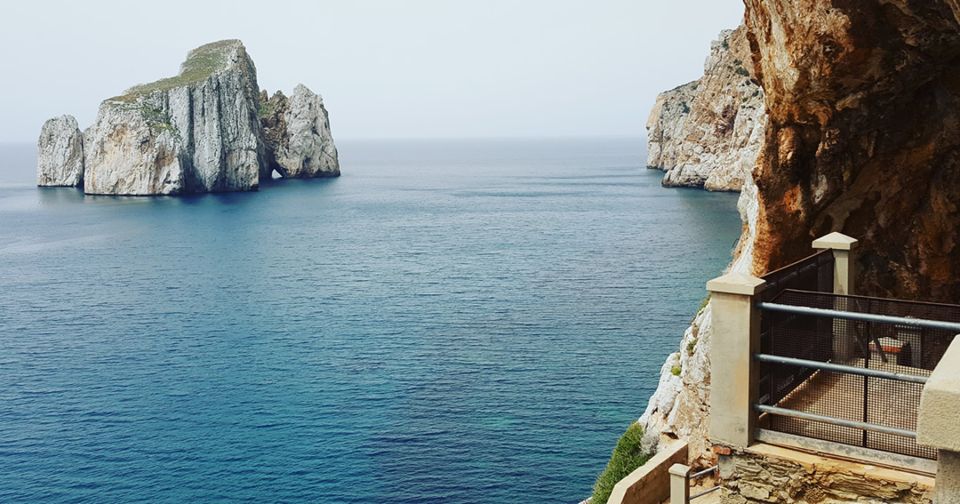Tucked away in the stunning landscape of southern Sardinia lies the captivating tour of Porto Flavia. This industrial marvel, once the heart of the island’s mining operations, offers visitors a unique glimpse into the innovative engineering and efficient transportation solutions that defined the early 20th century. Explore the network of tunnels, iron hatches, and electric railway that facilitated the rapid extraction and shipment of valuable ores. Discover the architectural touches that reflect the owner’s ambition to impress and the engineering prowess behind this remarkable mining complex. There’s more to uncover about this fascinating piece of Sardinian history.
Key Points

- Porto Flavia is a historic harbor located in the Sulcis area of Sardinia, named after the daughter of the engineer who oversaw its construction.
- The harbor was part of a larger mining complex developed in the early 1900s, showcasing the region’s rich natural resources and the ingenuity of its miners.
- Visitors can explore the innovative mining infrastructure, including mechanical iron hatches, an electric railway, and a conveyor belt system for efficient ore shipment.
- The mining complex was completed in just two years, a testament to the skilled workforce and advanced engineering techniques employed in its construction.
- Architectural touches, such as concrete towers and decorative nameplates, were added to the mining facilities to enhance the prestige and impact of the operation.
Exploring Masua Hub’s Mining Operations
The Masua hub was a complex of several mining operations in the Sulcis area, a region of Sardinia rich in natural resources.
Extraction began in 1600, but became economically relevant only in the early 1900s, when a special crew of miners expert in explosives and rock climbing was assembled to complete the excavations in record time.
These miners used small cavities at regular distances to gain cover after igniting explosives, which are still visible today.
The workers drilled the upper and lower tunnels simultaneously, allowing them to dump the removed rocks directly into the sea.
Mechanical iron hatches and an electric railway were installed in the upper tunnel to transport the ore.
You can also read our reviews of more tours and experiences in Cagliari.
Sulcis Area’s Natural Resources

The Sulcis area of Sardinia is rich in natural resources, with the region boasting a long history of mining and resource extraction that dates back to the 1600s.
Over the centuries, the area has been a hub for the exploitation of various minerals and materials, including the mining of lead, zinc, and other valuable ores. This wealth of natural resources has played a crucial role in the economic development of the region, supporting industries and providing employment for generations of Sardinian miners.
Today, the legacy of this resource-rich past can still be seen in the intricate network of tunnels, shafts, and other mining infrastructure that dot the landscape of the Sulcis area.
Sardinian Miners’ Expeditious Excavations

Assembling a special crew of miners expert in explosives and rock climbing, the company tasked them with completing the excavations in record time.
These skilled workers used small cavities at regular distances to gain cover after igniting explosives, leaving visible traces still seen today.
Drilling the upper and lower tunnels simultaneously, they could dump the removed rocks directly into the sea, boosting efficiency.
They also installed mechanical iron hatches and an electric railway in the upper tunnel to transport the ore.
With this expeditious approach, construction of the mining complex was finished in just two years, ending in 1924.
Tunnels, Hatches, and Railway Transport
To transport the ore, the company installed mechanical iron hatches and an electric railway in the upper tunnel. These efficient systems enabled the miners to move the extracted materials with ease, contributing to the rapid completion of the mining complex.
The workers drilled the upper and lower tunnels simultaneously, allowing them to dump the removed rocks directly into the sea. A main conveyor belt with a movable alignment system was used to load the ore onto ships, further streamlining the transportation process.
These innovative solutions showcased the ingenuity and determination of the Sardinian miners, who worked tirelessly to extract and transport the valuable resources from the Masua hub in record time.
More Great Tours NearbyConveyor Belt and Ore Shipment
A main conveyor belt with a movable alignment system facilitated the loading of ore onto ships, further streamlining the transportation process at the Masua mining complex. This innovative system allowed the workers to efficiently transfer the extracted ore from the upper tunnel directly onto waiting vessels.
The key benefits of this setup included:
- Faster loading times, as the conveyor belt could be precisely positioned to match the ship’s orientation.
- Reduced labor requirements, with fewer workers needed to manually load the ore.
- Improved safety, as the conveyor belt minimized the risk of accidents during the loading process.
This efficient ore shipment system was a testament to the engineering prowess and dedication of the Masua mining crew.
- Cagliari: Shore Excursion and City Highlights Tour
- Cagliari: 5-Hour Barumini Unesco Site Shore Excursion
- Cagliari: Luxury Personalized Charter Trips – Kymera43
- Cagliari: 5-Hour Archaeological Shore Excursion
- Cagliari: Castelsardo & the Sardinian Pyramide Private Tour
- Cagliari: Orosei Gulf Hop-On Hop-Off Mini Cruise
Architectural Touches and Company Prestige
The owners of the Masua mining complex took great pride in the architectural touches they incorporated into the site, adorning the ends of the tunnels facing the sea with concrete towers and decorative nameplates as a mark of prestige.
This was a deliberate decision, as the company wanted to showcase the impressive feat of engineering and construction that had been achieved. The concrete towers and nameplates were designed to impress visitors and showcase the company’s accomplishments.
This attention to detail and desire for prestige was a reflection of the importance the owners placed on the mining operation and its impact on the local economy and community.
The Engineer’s Daughter, Flavia
The harbor was named after the engineer’s daughter, Flavia, who was born in 1924 as the mining complex neared completion. The owner of the company had requested this as a mark of prestige, showcasing the personal connection between the project and his family.
Three interesting facts about Flavia and the naming of the harbor:
- Flavia was born the same year that construction on the mining complex was finished, in 1924.
- The owner chose to name the harbor after his daughter as a symbol of his pride and investment in the project.
- This personal touch was meant to elevate the prestige of the mining operation and its association with the owner’s family.
The harbor’s namesake, Flavia, represented the engineer’s successful completion of this ambitious mining enterprise.
Tour Inclusions and Exclusions
The Porto Flavia Tour includes several key inclusions that ensure a comprehensive experience for visitors, such as:
- Entrance fees
- Bottled water
- An Italian, English, French, and Portuguese-speaking local guide
Hotel pick-up and drop-off are provided for those staying in the Chia area, and the use of a helmet is included for safety. Transport is by air-conditioned minivan, and insurance is provided.
However, the tour excludes:
- Food and drinks, unless specifically stated
- Guides for Arabian, Chinese, German, Russian, Dutch, and Spanish speakers
Tips are also optional.
Frequently Asked Questions
How Accessible Is the Tour Site for Those With Mobility Issues?
The tour site may have limited accessibility for those with mobility issues. The guided tour involves navigating uneven terrain and narrow tunnels. Visitors with mobility constraints should consult the tour operator for details on accessibility accommodations available.
Are There Any Age Restrictions or Physical Requirements for the Tour?
There are no age restrictions, but the tour involves hiking and climbing, so a moderate level of physical fitness is required. Children under 12 must be accompanied by an adult. Visitors with mobility issues may have difficulty accessing parts of the site.
Can the Tour Be Customized or Personalized to Suit Individual Interests?
The tour can be customized to some degree to suit individual interests. Travelers can request additional stops or explore areas of particular interest, though the core itinerary and activities remain fixed. Flexibility may depend on group size and time constraints.
What Should Participants Bring or Wear for the Tour?
Participants should wear comfortable walking shoes, layered clothing suited for the weather, and sun protection like hats and sunscreen. It’s also a good idea to bring snacks, water, and a camera to capture the scenic views.
Are There Any COVID-19 Safety Protocols in Place During the Tour?
The tour follows COVID-19 safety protocols. Participants must wear masks, maintain social distancing, and sanitize their hands regularly. Group sizes are limited, and the tour provider conducts temperature checks before the start of the tour.
Recap
Porto Flavia offers a captivating glimpse into Sardinia’s mining heritage.
Visitors can explore the network of tunnels, iron hatches, and electric railway that facilitated the rapid extraction and shipment of valuable ores.
The architectural touches reflect the owner’s ambition to impress and showcase the engineering prowess behind this remarkable mining complex.
A tour of Porto Flavia provides an immersive experience into Sardinia’s industrial past.
You can check availability for your dates here:More Tours in Cagliari
- Sella Diavolo Eco-friendly Tour with Aperitif and Snacks
- Villasimius 3,5 hr Marine Park tour with snorkeling & drinks
- From Cagliari: Villasimius Beach tour Full-day
- From Cagliari: Chia Beaches Tour with van
- From Cagliari: Villasimius and Solanas Beaches Tour
- Cagliari Private Boat Tour: Swim, Prosecco, Aperitif & Chill
More Tour Reviews in Cagliari
- Sella Diavolo Eco-friendly Tour with Aperitif and Snacks
- Villasimius 3,5 hr Marine Park tour with snorkeling & drinks
- CITYBIKE/ easy Classic FOR 24 hours with Free delivery!
- From Cagliari: Villasimius Beach tour Full-day
- From Cagliari: Chia Beaches Tour with van
- From Cagliari: Villasimius and Solanas Beaches Tour
Not for you? Here's more nearby things to do in Cagliari we have reviewed
- Sella Diavolo Eco-friendly Tour with Aperitif and Snacks
- CITYBIKE/ easy Classic FOR 24 hours with Free delivery!
- From Cagliari: Villasimius Beach tour Full-day
- From Cagliari: Chia Beaches Tour with van
- From Cagliari: Villasimius and Solanas Beaches Tour
- SeaRent your SUP or Kayak from Cagliari to Villasimius
- Delivery bike for 6hours Castello/Molentargius/Poetto/Quartu
- Cagliari: Kayak 2/3 posti Rental SELLA DEL DIAVOLO CALAMOSCA
- Cagliari: Ceramics Workshop
- Cagliari Private Boat Tour: Swim, Prosecco, Aperitif & Chill
- Cagliari: Sella del Diavolo Boat Tour with Drinks and Snacks
- Cagliari: tour 4 soste snorkeling aperitivo
